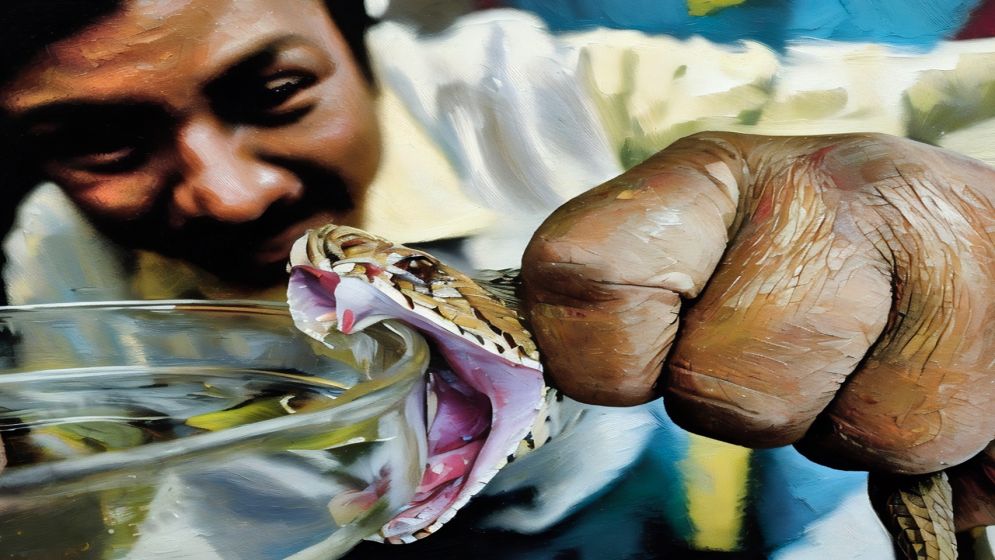Russell Viper frenzy on social media: Does the data support the hype?

For the last couple of weeks, social media in Bangladesh has been abuzz with posts, memes, and warnings about the Russell Viper, one of the world's deadliest snakes.
Known locally as "Chondrobora," its sudden resurgence in online discussions is surprising, as this species was declared nearly extinct in Bangladesh back in 2002.
Facebook is now filled with lengthy posts warning even urban dwellers, who typically experience very few snakebite cases, to prepare anti-venom and carbolic acid to protect themselves against this venomous snake.
Even reputable international media like the BBC, without providing supporting data, has reported a "surge in snake bites" in Bangladesh.
The British broadcaster stated a recent "increase in people being bitten by snakes, especially by the Russell's viper." However, the BBC hasn’t given any specific number on the people bitten by Russell's vipers this year or explained the cause of the alleged surge in snake bites.
Following reports of an “increase in snake bites”, the Bangladesh Health Minister, Dr. Samanta Lal Sen, has ordered all health centers and hospitals in the country to stock anti-venom.
The Minister also urged the public to promptly transport snake bite victims to hospitals for immediate treatment.
Based on data from the Venom Research Center (VRC) of Chattagram Medical College, Bangla Outlook found out that at least 10 people have died from Russell Viper bites this year in Bangladesh.
In the past 18 months, this number rose to 18, all occurring in the northwestern Barindra region, known for its red soil that provides an ideal habitat for Russell Vipers.
This data in fact suggests a rising trend in fatalities, as between January 2018 and December 2023, a total of 62 people died from Russell Viper bites, according to Rajshahi Medical College and Hospital (RMCH), the main treatment center for such cases.
This indicates an average of 10 deaths per year over the six-year period. However, with 10 deaths already recorded in the first six months of 2024, there is a 100% increase in fatalities compared to the annual average.
Another 2018 study by the Zoology Department of Chattagram University documented 20 deaths caused by Russell's Viper bites between 2013 and 2016. It means, in those four years, the average death from this snake bite was only five.
This suggests that deaths from Russell Viper bites have been on the rise in Bangladesh over the past decade.

Is there a surge in overall snake
bites?
A study titled "National Survey on Annual Incidence and Epidemiology of Snakebite in Bangladesh" conducted by the National Centre for Disease Control (NCDC) in 2023 reveals that approximately four lakh in Bangladesh are bitten by snakes each year, resulting in over 7,500 deaths.
Of these incidents, one-fourth involve venomous snakes.
The study's findings regarding snakebite fatalities however raise questions when compared to previous data.
In 2020, the Directorate General of Health Services (DGHS) reported six lakh bites annually, resulting in 6,000 deaths. A 2017 study published in the American Journal of Tropical Medicine and Hygiene estimated a higher number of bites, around nine lakh, but still with 6,000 annual deaths.
Contrasting with this earlier data, the 2023 NCDC study indicates that while the number of snakebites might have decreased, the number of fatalities has risen to over 7,500 per year.
This suggests a significant increase in the mortality rate associated with snakebites in Bangladesh.
Bangla Outlook tried to find out whether there is an overall increase in snake bite deaths [not just from Russell Viper] in the first six months of the year but was unable to find the data.
Abdul Awal, a researcher at VRC, explained that half-yearly data on snake bite deaths is not available because the DGHS compiles data from all hospitals across Bangladesh at the end of each year.
This data, including the number of snakebite patients and deaths, is prepared with the assistance of VRC.
However, Awal stated that the data they have so far does not indicate any “significant increase” in overall snakebite deaths this year.
Regarding the Russell Viper's sudden prominence in public discussion, Awal attributed it to recent sightings in unusual locations, such as Dohar near Dhaka and even in coastal districts like Bhola.
He explained, "Historically, the 'Chondrobora' snake was primarily found in northern districts of Bangladesh. In 2002, it was declared extinct due to very few sightings. However, it has unexpectedly reappeared. Its discovery near the capital has caused widespread panic."
Awal further commented, "But, to be honest, the current situation is largely fueled by social media."

Why the reemergence of Russell Viper?
Dr Farid Ahsan, a Supernumerary professor of Zoology at Chittagong University, who has researched the Russell's viper's re-emergence in Bangladesh, clarified that the snake was never completely extinct, but rather undocumented.
“It existed but remained undetected due to a lack of research at the time. However, its presence became noticeable again from 2013 onwards,” Dr Farid told Bangla Outlook.
Professor Farid also highlighted a contributing factor to the increase in Russell's viper numbers: their high survival rate due to live birth instead of egg-laying.
Additionally, agricultural intensification in the Barind region, with increased crop production leading to higher rat populations, has provided an abundant food source for these snakes.
Researchers meanwhile have also observed a potential pathway for Russell's vipers and other snakes to enter Bangladesh: by riding on hyacinth mats carried downstream during the monsoon season, particularly along the Padma River's entry point near Shibganj upazila in Chapainawabganj district.
The removal of bushes and vegetation along parts of the Padma Basin is another potential factor contributing to the spread of Russell's vipers.
This habitat alteration may have made it easier for the snakes to move downstream, expanding their range as far as Shariatpur district along the Padma Basin.
Researcher Md. Kamrul Hasan, a zoology professor at Jahangirnagar University, warns that the Russell's viper has adapted to changing weather conditions and will likely spread throughout Bangladesh.
"Research on captured or deceased Russell's vipers in Bangladesh revealed that 80% were female. A single female can produce up to 70 offspring at once, making this a concerning development," Hasan said.
He further elaborated, "Russell's vipers feed on rats and rodents, whose population has surged due to increased rice cultivation, leading to a greater concentration of vipers. Additionally, the decline in predators like mongooses and foxes has contributed to their growth."
The Zoology professor also pointed out that the indigenous Santal community in the northern region used to regularly hunt snakes, rats, and other animals, helping control reptile populations. “However, they have reduced such practices in recent years," he said.
—

